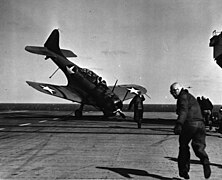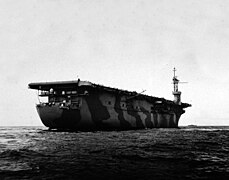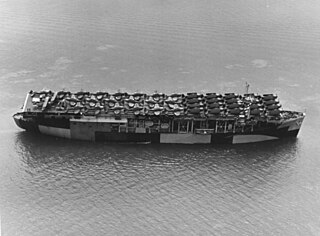
USS Long Island (CVE-1) was lead ship of her class and the first escort carrier of the United States Navy. She was also the second ship to be named after Long Island, New York.

The second USS Tangier (AV-8) was a Maritime Commission type C-3 cargo ship, converted to a seaplane tender in the United States Navy during World War II. The ship, the first of the C-3s to be launched and significant in a revival of Pacific coast shipbuilding, was launched 15 September 1939 and delivered to the Maritime Commission as Sea Arrow. The ship was acquired by the U.S. Navy during completion before any commercial service, put back into the builder's yard, and converted to a seaplane tender during 1940. After spending over a year in conversion the ship was commissioned on 25 August 1941.

The Turbine Steamship Fairsky was a one-class Italian-styled passenger ship operated by the Sitmar Line, best known for service on the migrant passenger route from Britain to Australia from May 1958 until February 1972. After a 20-month lay-up at Southampton, Fairsky completed two further voyages to Australia, before returning to be based at Sydney as a popular full-time cruise ship, until striking an unmarked wreck in 1977 which rendered the vessel uneconomic to permanently repair. The ship was finally sold to a Philippines based consortium, intended for static use as a casino and floating hotel. In 1979 during refurbishment at Manila Bay for her new role, a fire broke out onboard which destroyed the accommodation. The wreck was towed to Hong Kong for demolition in 1980.

USS Algorab (AKA-8) was laid down as Mormacwren, one of the earliest Maritime Commission-type C2 ships, on 10 August 1938 by the Sun Shipbuilding & Drydock Co., Chester, Pennsylvania as hull 177 for Moore-McCormack. Mormacwren was acquired by the United States Navy 6 June 1941, commissioned 15 June 1941 as USS Algorab (AK-25) and was redesignated an attack transport on 1 February 1943 with the hull number chanted to AKA-8. Algorab decommissioned on 3 December 1945 and was delivered to the Maritime Commission on 30 June 1946 for disposal, purchased by Wallem & Co. on 4 April 1947 for commercial service.

USS Refuge (AH-11), was a hospital ship of the United States Navy during World War II. The ship was built in 1921 by the New York Shipbuilding Corp., of Camden, New Jersey, as SS Blue Hen State, but was renamed President Garfield in 1923 and then SS President Madison in 1940 for service with American President Lines. Acquired by the Navy from the War Shipping Administration on 11 April 1942 the ship was commissioned as the transport USS Kenmore until conversion to a hospital ship.

USS Monadnock (ACM-10) was a coastal minelayer in the U.S. Navy, the third vessel named after Mount Monadnock, a solitary mountain (monadnock) of more than 3,100 feet in southern New Hampshire close to the border of Massachusetts. The ship was built as the cargo vessel Cavalier for the Philadelphia and Norfolk Steamship Company by Pusey and Jones Corporation, Wilmington, Delaware in 1938. The Navy purchased the ship 9 June 1941 for wartime use. After decommissioning the ship was sold in June 1947 for commercial use then sold to a Panamanian company in 1949 to be renamed Karukara. In 1952 the ship became Monte de la Esperanza for a company in Bilbao, Spain transporting bananas to the United Kingdom from the Canary Islands for more than 20 years. She was later sold to the Marine Institute of Spain for operation as a hospital ship for more than 10 years serving the fishing fleet of the Canary Islands as Esperanza del Mar until becoming an artificial reef off Spain in 2000.

USS Miantonomah (CM-10/CMc-5) was built as SS Quaker by Pusey & Jones Corporation, Wilmington, Delaware in 1938 as a commercial coastwise ship operating as a fast inland water passenger and freight carrier. Quaker was acquired by the Navy in May 1941 for conversion to a coastal minelayer. Miantonomah operated off the east coast of the United States, Africa and the Mediterranean and took part in the invasion of Europe in 1944. The ship was sunk by a mine 25 September 1944.
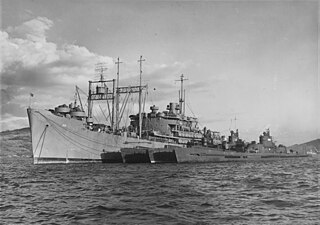
USS Euryale (AS-22) was built as the Hawaiian Merchant by the Federal Shipbuilding and Drydock Company in Kearny, New Jersey for the Matson Navigation Company. Hawaiian Merchant was launched 12 April 1941, minutes after sister ship Hawaiian Shipper, and was completed April 1941. Matson intended the ship to join Hawaiian Planter and Hawaiian Shipper in the U.S. Pacific Coast—Australia route. The ship was under United States Army Transportation Corps charter when the United States went to war and came under the control of the War Shipping Administration which allocated the ship to the Army's continued charter until the ship was purchased 15 April 1943 by the United States Navy and commissioned 2 December 1943 as USS Euryale (AS-22), serving as a submarine tender through the war. Euryale was decommissioned 7 October 1946, going into reserve until 9 August 1972 when she was delivered to the Maritime Administration with immediate sale to American Ship Dismantler, Inc. for disposal.
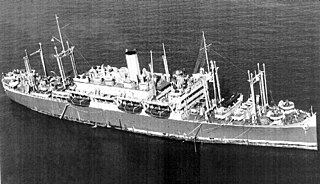
SS President Cleveland was originally built as Golden State for the United States Shipping Board (USSB), one of the planned World War I troop transports converted before construction into passenger and cargo vessels launched as Emergency Fleet Corporation Design 1029 ships first known, along with the smaller Design 1095 versions, in the trade as "State" ships due to names assigned for the nicknames of states and later as "535s" for their length overall. Almost all ships of both designs were renamed for United States presidents by May 1921, with Golden State being renamed President Cleveland. As one of the USSB-owned ships operated by agents of the board, President Cleveland was allocated to and operated by the Pacific Mail Steamship Company until sold by the USSB to the Dollar Steamship Line in 1925. After the demise of that line and creation of a new, replacement line, American President Lines, the ship remained with that line until government acquisition for the Second World War.

USS Mizar (AF-12) was the United Fruit Company fruit, mail and passenger liner Quirigua that served as a United States Navy Mizar-class stores ship in World War II.

USS Talamanca (AF-15) was the United Fruit Company cargo and passenger liner Talamanca that served as a United States Navy Mizar-class stores ship in World War II.

USS Merak (AF-21), the second Navy ship of the name, was the United Fruit Company cargo and passenger liner Veragua that served as a United States Navy Mizar-class stores ship in World War II.

The Seattle-Tacoma Shipbuilding Corporation was an American corporation which built escort carriers, destroyers, cargo ships and auxiliaries for the United States Navy and merchant marine during World War II in two yards in Puget Sound, Washington. It was the largest producer of destroyers (45) on the West Coast and the largest producer of escort carriers of various classes (56) of any United States yard active during World War II.
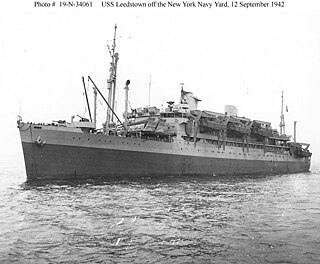
USS Leedstown (AP-73), built as the Grace Line passenger and cargo ocean liner SS Santa Lucia, served as a United States Navy amphibious assault ship in World War II. The ship had first been turned over to the War Shipping Administration (WSA) and operated by Grace Line as the WSA agent from February to August 1942 in the Pacific. In August the ship, at New York, was turned over to the Navy under sub-bareboat charter from WSA. She was sunk 9 November 1942 off the Algerian coast by a German submarine after German bombers caused damage the day before.

USS Henry T. Allen was a Harris class attack transport in service with the United States Army from 1940 to 1941. She was then transferred to the United States Navy where she served until 1946. She was scrapped in 1948. The ship was originally built as an Emergency Fleet Corporation Design 1029 ship in 1919 and operated in commercial service as Wenatchee and President Jefferson until being laid up in 1938.

USS George F. Elliott (AP-105) was a cargo liner built for the Mississippi Shipping Company as SS Delbrasil for operation between New Orleans and the east coast of South America in 1939 by its operator, Delta Line. The ship entered that service and operated until taken over by the War Shipping Administration (WSA) on 28 April 1942 for operation by Delta Line acting as WSA's agent. On 25 August 1943 WSA allocated the ship to the Navy for conversion to a troop transport commissioned and operated by the Navy for the duration of the war. Ownership of the ship was transferred from Mississippi Shipping to WSA on 4 February 1944 while under Navy operation and was retained until sale to American South African Lines on 22 December 1948. The ship was renamed African Endeavor until returned as a trade in to the Maritime Commission on 22 September 1960 for layup in the James River reserve fleet and later sold to Boston Metals for scrapping.

SS Antigua was a United Fruit Company passenger and refrigerated cargo liner completed as one of six nearly identical vessels, three built by Newport News Shipbuilding and three by Bethlehem Shipbuilding Corporation, for operation by the company's subsidiary the United Mail Steamship Company. The ship was the first of the ships built by Bethlehem Shipbuilding Corporation, Quincy, Massachusetts.

SS President Taft was launched as one of the "state" ships, Buckeye State, completed by the United States Shipping Board as cargo passenger ships after originally being laid down as troop transports. Buckeye State had been laid down as Bertrice but was converted and renamed before launching. Originally assigned to the Matson Navigation Company as the Shipping Board's agent, the ship was later renamed President Taft and assigned to Pacific Mail Steamship Company for operation. In 1925 the Shipping Board sold the ship to Dollar Steamship Company. President Taft was operated by Dollar and then its successor American President Lines until requisitioned by the War Department on 17 June 1941.
The Design 1095 ship was an Emergency Fleet Corporation (EFC) design for a troop transport to be built at New York Shipbuilding Corporation and delivered to the United States Shipping Board (USSB) that, at the end of World War I hostilities, was modified to a combined passenger and cargo vessel. The contract was for thirteen ships, EFC hulls 2579 though 2591, but later adjusted to seven ships with the remainder being changed during construction to the slightly larger ships of EFC Design 1029 built from the start as passenger and cargo ships rather than being modified from the troop ship plan.
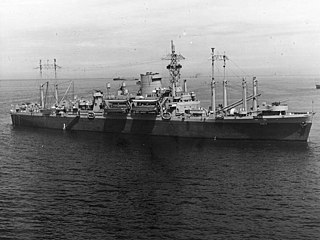
SS Panama was laid down 25 October 1937 as hull number 1467, launched on 24 September 1938 and completed 22 April 1939 at Bethlehem Shipbuilding Corporation in Quincy Massachusetts. The ship was given the official number 238343 and was owned and operated by the Panama Railroad Company. The ship was built for 202 single class passengers with a crew of 124. Panama was sister ship to USS Ancon and SS Cristobal.


